3D Thermal Network Supported by CF Felt for Improving the Thermal Performance of CF/C/Epoxy Composites
Abstract
1. Introduction
2. Materials and Methods
2.1. Materials
2.2. Preparation Method of CF Felt
2.3. Preparation Method of CF/C Felt
Preparation Method of the CF/C/EP Composite
2.4. Characterization Methods
3. Results and Discussions
3.1. The Preparation and Morphology of the CF Composites
3.2. The Heat Resistance of the CF/C/EP Composite
3.3. Thermal Conductivity of the CF/C/EP Composites
3.4. Thermal Management Performance of the CF/C/EP Composite
4. Conclusions
Author Contributions
Funding
Institutional Review Board Statement
Informed Consent Statement
Data Availability Statement
Conflicts of Interest
References
- Yang, T.T.; Jiang, Z.Y.; Han, H.M.; Cai, X.Z.; Liu, Y.Q.; Zhang, X.R.; Zhang, X.X.; Ren, Y.J.; Hu, J. Welding dopamine modified graphene nanosheets onto graphene foam for high thermal conductive composites. Compos. Part. B Eng. 2021, 205, 108509. [Google Scholar] [CrossRef]
- Windberger, M.S.; Dimitriou, E.; Rendl, S.; Wewerka, K.; Wiesbrock, F. Temperature-Triggered/Switchable Thermal Conductivity of Epoxy Resins. Polymers 2021, 13, 65. [Google Scholar] [CrossRef] [PubMed]
- Neves, R.M.; Vanzetto, A.B.; Lazzari, L.K.; Zattera, A.J. Thermal and dynamic mechanical behavior of epoxy composites reinforced with post-consumed yerba mate. J. Appl. Polym. Sci. 2021, 138. [Google Scholar] [CrossRef]
- Sankhavara, D.B.; Chopda, J.V.; Patel, J.P.; Parsania, P.H. Spectral and thermal analysis of aromatic diamines and anhydrides cured chalcone moiety containing epoxy resin of (2E,6E)-bis(4-hydroxybenzylidene)cyclohexanone. J. Therm. Anal. Calorim. 2021, 1–8. [Google Scholar] [CrossRef]
- Wu, X.; Wang, Y.; Jiang, P.; Zhang, F.; Zhang, X.; Yang, K. Highly Thermal Conductive Organic Polymer System of PMMA/(Core-shell Structured BaTiO3@PMMA Nanoparticles). Chin. J. Org. Chem. 2014, 34, 2309–2316. [Google Scholar] [CrossRef][Green Version]
- Ali, Z.; Gao, Y.; Tang, B.; Wu, X.F.; Wang, Y.; Li, M.H.; Hou, X.; Li, L.H.; Jiang, N.; Yu, J.H. Preparation, Properties and Mechanisms of Carbon Fiber/Polymer Composites for Thermal Management Applications. Polymers 2021, 13, 169. [Google Scholar] [CrossRef]
- Hou, J.; Wang, Y.; Liu, J.; Zhao, J.; Long, S.; Hao, J. Enhanced thermal conductivity of copper-doped polyethylene glycol/urchin-like porous titanium dioxide phase change materials for thermal energy storage. Int. J. Energy Res. 2020, 44, 1909–1919. [Google Scholar] [CrossRef]
- Misiura, A.I.; Mamunya, Y.P.; Kulish, M.P. Metal-Filled Epoxy Composites: Mechanical Properties and Electrical/Thermal Conductivity. J. Macromol. Sci. Part. B Phys. 2020, 59, 121–136. [Google Scholar] [CrossRef]
- Zhou, W.; Zhang, F.; Yuan, M.; Li, B.; Peng, J.; Lv, Y.; Cai, H.; Liu, X.; Chen, Q.; Dang, Z.-M. Improved dielectric properties and thermal conductivity of PVDF composites filled with core-shell structured Cu@CuO particles. J. Mater. Sci. Mater. Electron. 2019, 30, 18350–18361. [Google Scholar] [CrossRef]
- Yang, D.; Ni, Y.; Liang, Y.; Li, B.; Ma, H.; Zhang, L. Improved thermal conductivity and electromechanical properties of natural rubber by constructing Al2O3-PDA-Ag hybrid nanoparticles. Compos. Sci. Technol. 2019, 180, 86–93. [Google Scholar] [CrossRef]
- Huang, J.; Yang, W.; Zhu, J.; Fu, L.; Li, D.; Zhou, L. Silver nanoparticles decorated 3D reduced graphene oxides as hybrid filler for enhancing thermal conductivity of polystyrene composites. Compos. Part. A Appl. Sci. Manuf. 2019, 123, 79–85. [Google Scholar] [CrossRef]
- Li, J.; Wang, B.; Ge, Z.; Cheng, R.; Kang, L.; Zhou, X.; Zeng, J.; Xu, J.; Tian, X.; Gao, W.; et al. Flexible and Hierarchical 3D Interconnected Silver Nanowires/Cellulosic Paper-Based Thermoelectric Sheets with Superior Electrical Conductivity and Ultrahigh Thermal Dispersion Capability. Acs Appl. Mater. Interfaces 2019, 11, 39088–39099. [Google Scholar] [CrossRef] [PubMed]
- Yang, X.; Fan, S.; Li, Y.; Guo, Y.; Li, Y.; Ruan, K.; Zhang, S.; Zhang, J.; Kong, J.; Gu, J. Synchronously improved electromagnetic interference shielding and thermal conductivity for epoxy nanocomposites by constructing 3D copper nanowires/thermally annealed graphene aerogel framework. Compos. Part. A Appl. Sci. Manuf. 2020, 128, 105670. [Google Scholar] [CrossRef]
- Zhang, L.; Zhu, W.; Huang, Y.; Qi, S. Synergetic Effects of Silver Nanowires and Graphene Oxide on Thermal Conductivity of Epoxy Composites. Nanomaterials 2019, 9, 1264. [Google Scholar] [CrossRef]
- Cheng, X.; Zhang, J.; Wang, H.; Wu, L.; Sun, Q. Improving the interlaminar shear strength and thermal conductivity of carbon fiber/epoxy laminates by utilizing the graphene-coated carbon fiber. J. Appl. Polym. Sci. 2019, 136, 47061. [Google Scholar] [CrossRef]
- Bard, S.; Schoenl, F.; Demleitner, M.; Altstaedt, V. Influence of Fiber Volume Content on Thermal Conductivity in Transverse and Fiber Direction of Carbon Fiber-Reinforced Epoxy Laminates. Materials 2019, 12, 1084. [Google Scholar] [CrossRef] [PubMed]
- Badakhsh, A.; Han, W.; Jung, S.-C.; An, K.-H.; Kim, B.-J. Preparation of Boron Nitride-Coated Carbon Fibers and Synergistic Improvement of Thermal Conductivity in Their Polypropylene-Matrix Composites. Polymers 2019, 11, 2009. [Google Scholar] [CrossRef] [PubMed]
- Jiang, J.; Yang, S.; Li, L.; Bai, S. High thermal conductivity polylactic acid composite for 3D printing: Synergistic effect of graphene and alumina. Polym. Adv. Technol. 2020, 31, 1291–1299. [Google Scholar] [CrossRef]
- Chen, Y.; Hou, X.; Liao, M.; Dai, W.; Wang, Z.; Yan, C.; Li, H.; Lin, C.-T.; Jiang, N.; Yu, J. Constructing a “pea-pod-like” alumina-graphene binary architecture for enhancing thermal conductivity of epoxy composite. Chem. Eng. J. 2020, 381, 122690. [Google Scholar] [CrossRef]
- Chen, W.; Wu, K.; Liu, Q.; Lu, M. Functionalization of graphite via Diels-Alder reaction to fabricate poly (vinyl alcohol) composite with enhanced thermal conductivity. Polymer 2020, 186, 2075. [Google Scholar] [CrossRef]
- Saleem, A.; Zhang, Y.; Gong, H.; Majeed, M.K.; Jing, J.; Lin, X.; Ashfaq, M.Z. Enhanced thermal conductivity and mechanical properties of a GNP reinforced Si3N4 composite. RSC Adv. 2019, 9, 39986–39992. [Google Scholar] [CrossRef]
- Hassanzadeh-Aghdam, M.K.; Mahmoodi, M.J.; Jamali, J.; Ansari, R. A new micromechanical method for the analysis of thermal conductivities of unidirectional fiber/CNT-reinforced polymer hybrid nanocomposites. Compos. Part. B Eng. 2019, 175, 107137. [Google Scholar] [CrossRef]
- Yan, R.; Su, F.; Zhang, L.; Li, C. Highly enhanced thermal conductivity of epoxy composites by constructing dense thermal conductive network with combination of alumina and carbon nanotubes. Compos. Part. A Appl. Sci. Manuf. 2019, 125, 105496. [Google Scholar] [CrossRef]
- Mishra, A.K.; Lahiri, B.B.; Philip, J. Superior thermal conductivity and photo-thermal conversion efficiency of carbon black loaded organic phase change material. J. Mol. Liq. 2019, 285, 640–657. [Google Scholar] [CrossRef]
- Mishra, A.K.; Lahiri, B.B.; Philip, J. Carbon black nano particle loaded lauric acid-based form-stable phase change material with enhanced thermal conductivity and photo-thermal conversion for thermal energy storage. Energy 2020, 191, 116572. [Google Scholar] [CrossRef]
- Wang, F.; Shi, W.; Mai, Y.; Liao, B. Effect of Thermal Conductive Fillers on the Flame Retardancy, Thermal Conductivity, and Thermal Behavior of Flame-Retardant and Thermal Conductive Polyamide 6. Materials 2019, 12, 4114. [Google Scholar] [CrossRef]
- Liu, L.; Cao, C.; Ma, X.; Zhang, X.; Lv, T. Thermal conductivity of polyimide/AlN and polyimide/(AlN plus BN) composite films prepared by in-situ polymerization. J. Macromol. Sci. Part. A Pure Appl. Chem. 2020, 57, 398–407. [Google Scholar] [CrossRef]
- Tang, Y.; Xiao, C.; Ding, J.; Hu, K.; Zheng, K.; Tian, X. Synergetic enhancement of thermal conductivity in the silica-coated boron nitride (SiO2@BN)/polymethyl methacrylate (PMMA) composites. Colloid Polym. Sci. 2020, 298, 385–393. [Google Scholar] [CrossRef]
- Shen, W.; Wu, W.; Liu, C.; Wang, Y.; Zhang, X. Thermal conductivity enhancement of PLA/TPU/BN composites by controlling BN distribution and annealing treatment. Plast. Rubber Compos. 2020, 49, 204–213. [Google Scholar] [CrossRef]
- Ma, X.; Liu, L.; Zhang, X.; Lv, T. Thermal conductivity enhancement of polyimide films filled with BN and AlN fillers. High. Perform. Polym. 2019, 31, 959–968. [Google Scholar] [CrossRef]
- Hu, F.; Xie, Z.-P.; Zhang, J.; Hu, Z.-L.; An, D. Promising high-thermal-conductivity substrate material for high-power electronic device: Silicon nitride ceramics. Rare Met. 2020, 39, 463–478. [Google Scholar] [CrossRef]
- Chen, H.; Wang, W.; Yu, X.; Zuo, K.-h.; Xia, Y.; Yin, J.; Liang, H.; Yao, D.; Zeng, Y.-P. The effect of annealing temperature on flexural strength, dielectric loss and thermal conductivity of Si3N4 ceramics. J. Alloys Compd. 2020, 813, 152203. [Google Scholar] [CrossRef]
- Yao, Y.; Ye, Z.; Huang, F.; Zeng, X.; Zhang, T.; Shang, T.; Han, M.; Zhang, W.; Ren, L.; Sun, R.; et al. Achieving Significant Thermal Conductivity Enhancement via an Ice-Templated and Sintered BN-SiC Skeleton. Acs Appl. Mater. Interfaces 2020, 12, 2892–2902. [Google Scholar] [CrossRef]
- Zou, Z.; Wu, W.; Wang, Y.; Wang, L. Enhancement of thermal conductivity and tensile strength of liquid silicone rubber by three-dimensional alumina network. Soft Mater. 2019, 17, 297–307. [Google Scholar] [CrossRef]
- Lule, Z.; Yang, J.; Kim, J. A Study on the Thermal Conductivity of Poly(lactic acid)/Alumina Composites: The Effect of the Filler Treatment. J. Nanosci. Nanotechnol. 2020, 20, 229–238. [Google Scholar] [CrossRef] [PubMed]
- Cho, M.; Ko, F.K.; Renneckar, S. Impact of Thermal Oxidative Stabilization on the Performance of Lignin-Based Carbon Nanofiber Mats. Acs Omega 2019, 4, 5345–5355. [Google Scholar] [CrossRef] [PubMed]
- Wu, X.F.; Tang, B.; Chen, J.; Shan, L.M.; Gao, Y.; Yang, K.; Wang, Y.; Sun, K.; Fan, R.H.; Yu, J.H. Epoxy composites with high cross-plane thermal conductivity by constructing all-carbon multidimensional carbon fiber/graphite networks. Compos. Sci. Technol. 2021, 203, 108610. [Google Scholar] [CrossRef]
- Zhang, P.; Kou, K.; Deng, Z.; Wu, G. Performance Analysis of Carbon Black/Carbon-Fiber Double-Layer Spacer Fabric/Epoxy Resin Composite Materials. Fibers Polym. 2019, 20, 856–862. [Google Scholar] [CrossRef]
- Li, K.-Z.; Li, L.; Li, H.-J.; Song, Q.; Lu, J.-H.; Fu, Q.-G. Electrophoretic deposition of carbon nanotubes onto carbon fiber felt for production of carbon/carbon composites with improved mechanical and thermal properties. Vacuum 2014, 104, 105–110. [Google Scholar] [CrossRef]
- Xu, T.; Zhou, S.; Cui, S.; Song, N.; Shi, L.; Ding, P. Three-dimensional carbon fiber-graphene network for improved thermal conductive properties of polyamide-imide composites. Compos. Part. B Eng. 2019, 178, 107495. [Google Scholar] [CrossRef]
- Ma, J.; Shang, T.; Ren, L.; Yao, Y.; Zhang, T.; Xie, J.; Zhang, B.; Zeng, X.; Sun, R.; Xu, J.-B.; et al. Through-plane assembly of carbon fibers into 3D skeleton achieving enhanced thermal conductivity of a thermal interface material. Chem. Eng. J. 2020, 380. [Google Scholar] [CrossRef]
- Hou, X.; Chen, Y.; Dai, W.; Wang, Z.; Li, H.; Lin, C.-T.; Nishimura, K.; Jiang, N.; Yu, J. Highly thermal conductive polymer composites via constructing micro-phragmites communis structured carbon fibers. Chem. Eng. J. 2019, 375. [Google Scholar] [CrossRef]
- Sheng, N.; Rao, Z.; Zhu, C.; Habazaki, H. Honeycomb carbon fibers strengthened composite phase change materials for superior thermal energy storage. Appl. Therm. Eng. 2020, 164, 114493. [Google Scholar] [CrossRef]
- He, X.; Huang, Y.; Liu, Y.; Zheng, X.; Kormakov, S.; Sun, J.; Zhuang, J.; Gao, X.; Wu, D. Improved thermal conductivity of polydimethylsiloxane/short carbon fiber composites prepared by spatial confining forced network assembly. J. Mater. Sci. 2019, 54, 10078. [Google Scholar] [CrossRef]
- Cho, J.; Lee, S.-K.; Eem, S.-H.; Jang, J.G.; Yang, B. Enhanced mechanical and thermal properties of carbon fiber-reinforced thermoplastic polyketone composites. Compos. Part. A Appl. Sci. Manuf. 2019, 126. [Google Scholar] [CrossRef]
- Wei, J.; Liao, M.; Ma, A.; Chen, Y.; Duan, Z.; Hou, X.; Li, M.; Jiang, N.; Yu, J. Enhanced thermal conductivity of polydimethylsiloxane composites with carbon fiber. Compos. Commun. 2020, 17, 141–146. [Google Scholar] [CrossRef]
- Wang, H.; Li, L.; Chen, Y.; Li, M.; Fu, H.; Xiao, H.; Wu, X.; Lin, C.-T.; Jiang, N.; Yu, J. Efficient Thermal Transport Highway Construction Within Epoxy Matrix via Hybrid Carbon Fibers and Alumina Particles. ACS Omega 2020, 5, 1170–1177. [Google Scholar] [CrossRef] [PubMed]
- Liang, M.; Fu, C.; Xiao, B.; Luo, L.; Wang, Z. A fractal study for the effective electrolyte diffusion through charged porous media. Int. J. Heat Mass Transf. 2019, 137, 365–371. [Google Scholar] [CrossRef]
- Xiao, B.; Zhang, Y.; Wang, Y.; Wang, W.; Chen, H.; Chen, X.; Long, G. An Investigation on Effective Thermal Conductivity of Unsaturated Fractal Porous Media with Roughened Surfaces. Fractals Complex. Geom. Patterns Scaling Nat. Soc. 2020, 28, 2050080-1642. [Google Scholar] [CrossRef]
- Xiao, B.; Wang, S.; Wang, Y.; Jiang, G.; Zhang, Y.; Chen, H.; Liang, M.; Long, G.; Chen, X. Effective Thermal Conductivity of Porous Media with Roughened Surfaces by Fractal-Monte Carlo Simulations. Fractals Complex. Geom. Patterns Scaling Nat. Soc. 2020, 28, 2050029. [Google Scholar] [CrossRef]









| Samples | CF/C [vol%] | CF/C [wt%] |
|---|---|---|
| CF/C/EP-1 | 11.3 | 17.0 |
| CF/C/EP-1.5 | 15.8 | 23.3 |
| CF/C/EP-2 | 22.8 | 32.2 |
| CF/C/EP-2.5 | 25.3 | 35.2 |
Publisher’s Note: MDPI stays neutral with regard to jurisdictional claims in published maps and institutional affiliations. |
© 2021 by the authors. Licensee MDPI, Basel, Switzerland. This article is an open access article distributed under the terms and conditions of the Creative Commons Attribution (CC BY) license (http://creativecommons.org/licenses/by/4.0/).
Share and Cite
Wu, X.; Gao, Y.; Jiang, T.; Zheng, L.; Wang, Y.; Tang, B.; Sun, K.; Zhao, Y.; Li, W.; Yang, K.; et al. 3D Thermal Network Supported by CF Felt for Improving the Thermal Performance of CF/C/Epoxy Composites. Polymers 2021, 13, 980. https://doi.org/10.3390/polym13060980
Wu X, Gao Y, Jiang T, Zheng L, Wang Y, Tang B, Sun K, Zhao Y, Li W, Yang K, et al. 3D Thermal Network Supported by CF Felt for Improving the Thermal Performance of CF/C/Epoxy Composites. Polymers. 2021; 13(6):980. https://doi.org/10.3390/polym13060980
Chicago/Turabian StyleWu, Xinfeng, Yuan Gao, Tao Jiang, Lingyu Zheng, Ying Wang, Bo Tang, Kai Sun, Yuantao Zhao, Wenge Li, Ke Yang, and et al. 2021. "3D Thermal Network Supported by CF Felt for Improving the Thermal Performance of CF/C/Epoxy Composites" Polymers 13, no. 6: 980. https://doi.org/10.3390/polym13060980
APA StyleWu, X., Gao, Y., Jiang, T., Zheng, L., Wang, Y., Tang, B., Sun, K., Zhao, Y., Li, W., Yang, K., & Yu, J. (2021). 3D Thermal Network Supported by CF Felt for Improving the Thermal Performance of CF/C/Epoxy Composites. Polymers, 13(6), 980. https://doi.org/10.3390/polym13060980








